 |
|
|
|
||
Binocular Advice |
||
Binocular Recommendations Almost any pair of binoculars about $250 or more should prove satisfactory in optical quality and craftsmanship for lifelong terrestrial and celestial use. Try to buy locally in order to find a pair that fits comfortably in your hands—this is important. Diameter of objective and magnification. Purchase a pair that can be used for both astronomical and daytime adventures: 7x40, 10x40, 7x50 or 10x50 are good choices. The first number indicates the magnification while the second number indicates the diameter of the front lens in millimeters. A 35mm lens or smaller is a little too small for astronomical use. Those with magnifications above 10x are difficult to hold steady and require a tripod for best use. Avoid buying binoculars with a number starting with 11 or higher. Optical design. Both roof- and porro- prisms are good designs. Roof-prisms are more compact (and look “cooler”), more expensive, heavier and less comfortable to hold. Overall, porro-prisms are the best deal for the money and the most comfortable to hold. See pictures at right and below. Tripod consideration. For exploring the heavens, a camera tripod will help immensely to steady the view and eliminate arm fatigue. However, this is an item you can purchase at a later date. Warranty. Some companies offer a life-time alignment warranty, however, choose a major company that you think will be around 20 years from now. Return policy. Inquire about the return policy, especially if you purchase online and/or as a gift because not all binoculars are comfortable to hold in your hands. ________________________
Want Advice? If you have a question or would like advice on buying a telescope, binoculars or accessory, please email me (Ken Graun) at AstroInfo. No charge, no obligation, no hassles. |
|||||
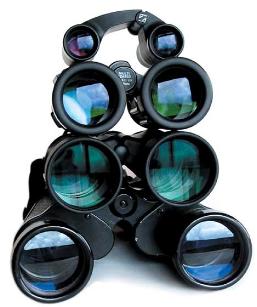 |
|||||
The lenses of most binoculars have special coatings to increase light transmission. Coatings produce color casts of green, blue and purple as can be seen from these lenses (some are orange, too). Although coatings are lasting and durable, care must be taken when cleaning lenses because they can be scratched. |
|||||
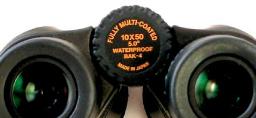 |
|||||
Binoculars are classified by their magnification and front-lens diameter. This pair is a 10x50, which is indicated on the focusing knob. 10x is the magnification and 50 the diameter of either front lens in millimeters. |
|||||
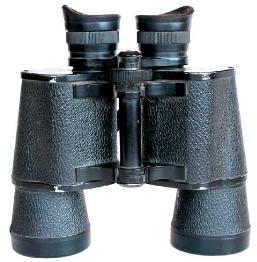 |
|||||||
Binoculars |
|||||||
Although most of us want a telescope for observing the heavens, I rate binoculars excellent as an instrument for celestial exploration. They offer the comfort of two-eye viewing and capture greater vistas than is possible with telescopes. And, since many of us already own a pair of binoculars, we can use them to go out and start observing right away. Today, almost all middle-of-the-line binoculars, ranging in price from $250 to $350, offer good optical performance. Binoculars add a dimension to observing that cannot be achieved with telescopes. In my opinion, the most beautiful sights of the Pleiades and the Praesepe come through binoculars. These clusters fill the binoculars’ field of view and give the impression that the stars are floating in front of you. Classification of binoculars • 7x50, etc. Comparing binoculars for astronomical use — Using that little “x” Other considerations when purchasing binoculars Magnification limitations Viewing comfort and eyeglasses Comfortable ergonomics Multi-coated optics Field of view Large, high-powered binoculars
Tripods Attaching your binoculars to a camera tripod is very helpful when exploring the heavens because it steadies your view and eliminates arm fatigue. You can also lean on the tripod, which makes it easier to stand in one spot for a long period of time. There are also specialized parallelogram-type binocular mounts that are particularly useful with groups because they keep an object in view even when the binoculars are moved up or down to accommodate individuals of different heights. Parallelogram-type mounts can be used when standing or adapted for sitting and reclining positions. Today, most binoculars come with a tripod socket that allows attachment to a tripod head; however, you need to purchase an adapter. Many older binoculars don’t have sockets, so you may have to get creative to latch these down. Aiming towards the sky |
|||||||
ABOVE. Porro-Prism Binoculars You may already have a pair of these binoculars lying around, so observing the sky is just a matter of finding them and stepping outside. Porros are a proven design identified by the offset of the eyepieces from the front lenses. They are also very comfortable to hold. Although this design is bigger and thus bulkier than roof-prism binoculars, it can edge out the performance of roof-prism binoculars at a lower cost. BELOW. Roof-Prism Binoculars Nature lovers and hikers often prefer this type of binoculars because they are compact in comparison to porro-prism binoculars; however, they are usually more expensive. Although these binoculars look like two small, side-by-side refractor telescopes, they incorporate several internal prisms to provide upright imagery. Quality roof-prism binoculars perform just as well as porro-prism binoculars. |
|||||||
 |
|||||||
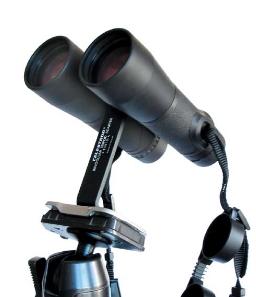 |
|||||||
Tripod adapters are used to attach binoculars to tripods. Note: Not all adapters will fit the tighter barrel constraints of roof-prism binoculars. |
|||||||
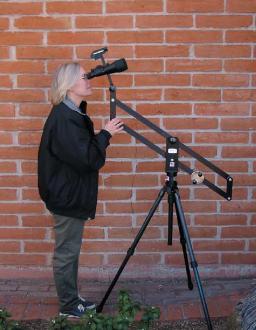 |
||
Parallelogram-type mounts are great for groups. The binoculars stay on target even if moved up or down to accommodate different height individuals. Note the reflex-sight finder on top of the binoculars to aid in pointing. |
||
What’s Out Tonight? is sponsored by Ken Press, publisher of astronomy books and charts. |
||